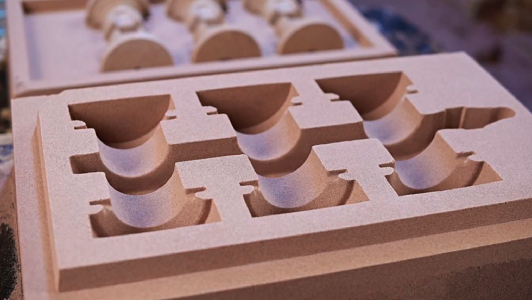 Add My Company
Add My Company

In this article we consider the differences and similarities between two closely related casting processes. Both use sand moulds to produce castings but the differences in the processes make them suited to quite different applications.
Sand casting is one of the oldest casting processes dating back at least 5000 years. The simplicity and versatility of the process have ensured that it has endured and become a cornerstone of modern metal casting. It is estimated that around 70% of castings worldwide continue to use this process.
Sand casting is routinely used for casting both ferrous and non-ferrous alloys in sizes ranging from just a few grams to many tonnes. Complex structures can be created easily using internal cores to create voids within the structure. The sand moulds used in the process can be made using wood or 3D printed patterns so tooling costs are low and the process can be fully manual or highly automated, making it suitable for low quantities as well as longer production runs. The sand mould is made using clay or resin as the binding agent, which are cheap, keeping overall cost of the process low, and the entire process can be completed very quickly.
What sand casting gains in versatility and cost, however, it can lose in refinement. The relatively coarse sand grains used in greensand and resin sand casting can leave a course surface finish and wall thicknesses need to be at least 3mm for light alloys and 5 to 6mm for steel and other ferrous alloys. The other main issue with sand casting is its lack of geometric precision compared to other casting processes. This can, in turn, mean that more post-casting finishing and machining is needed to achieve the required tolerances.
As with sand casting, shell moulding can be used for both ferrous and non-ferrous castings. Although shell mould casting also involves pouring molten metal into an expendable sand-based mould, the process in getting to that point, and the achievable castings, are very different. In shell mould casting, the mould is a thin-walled shell created by applying a sand-resin mixture around a pattern. The pattern, a metal piece in the shape of the desired part, is reused to form multiple shell moulds. Compared to sand casting, shell mould casting requires minimal draft angle to allow extraction of the mould (shell) from the pattern. A reusable pattern allows for higher production rates, while the disposable moulds enable complex geometries to be cast. Once created and cured in an oven, the shell mould is set within a flask and supported by backing material.
The surface finish achievable with shell mould casting is much better than sand casting due to the finer-grained sand that is used and the phenolic resin binding agent, which together produce an exceptionally smooth surface. The more refined process also allows fine surface detail to be reproduced while tight tolerances can be achieved with much thinner walls. Consequently, much less, if any post-casting finishing and machining may be required.
So why isn’t shell mould casting used in preference to sand casting more often? There are cost and size limitations to shell mould casting. The process of creating the shell mould takes longer and the phenolic resin is more expensive than the resins and binders used in sand casting. Tooling costs can also be higher as the pattern needs to be made from metal to cope with the baking process required to cure the shell mould. Compared to sand casting, shell moulding is somewhat limited in size and weight with maximum cast weights of up to 30kg. Complex shapes can be achieved with shell mould casting but it is more difficult to use sand cores successfully.
Typical parts cast using the shell mould process are small-to-medium in size and require high accuracy, such as gear housings, cylinder heads, connecting rods, and lever arms.
Ultimately the choice of casting process will come down to the specification of the casting in terms of size and weight, technical considerations relating to tolerances, surface finishes and internal structures, and cost factors relating to tooling, mould manufacture and production runs. At NovaCast, we offer both casting processes to customers, together with a range of others, so are well place to advise on the most suitable for each application.
If you are investigating the best option for a cast or machined component and need to call on our experience and expertise we would be delighted to hear from you. Call a member of NovaCast’s team on +44 (0) 1225 707466, send us a message here or email sales@novacast.co.uk.
For more information on Casting Process Comparison: Sand Casting vs Shell Mould Casting talk to Novacast Limited

